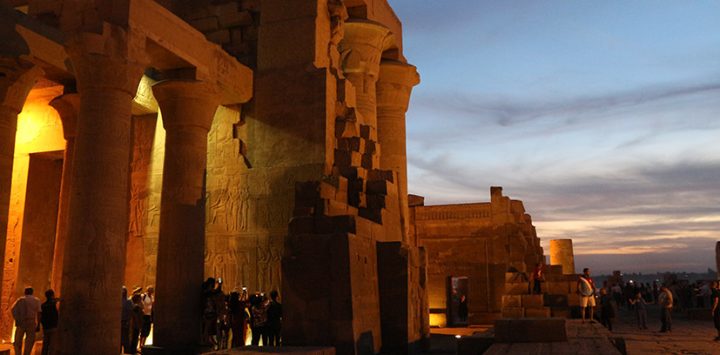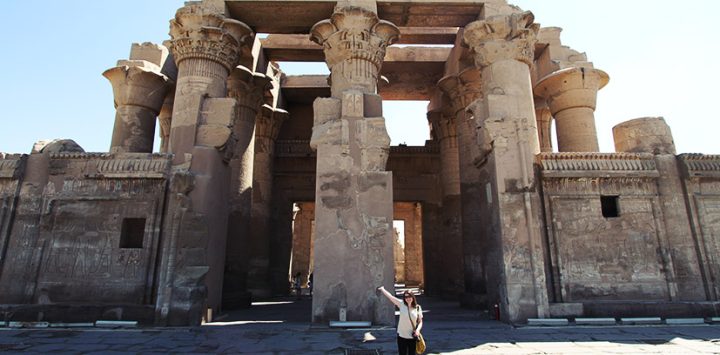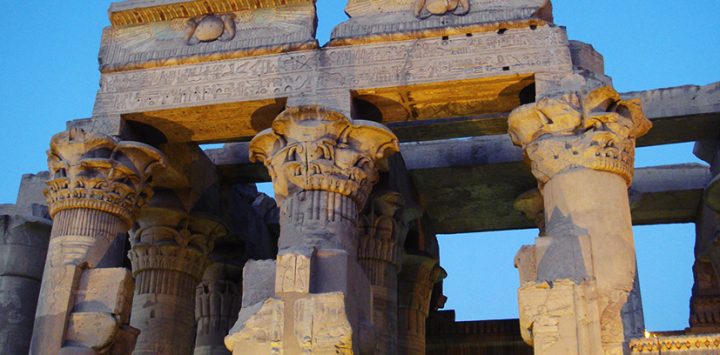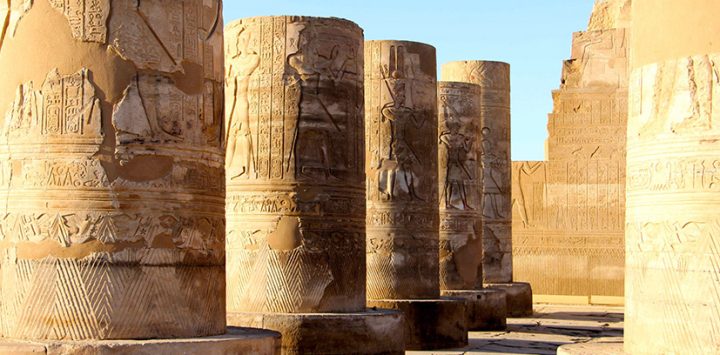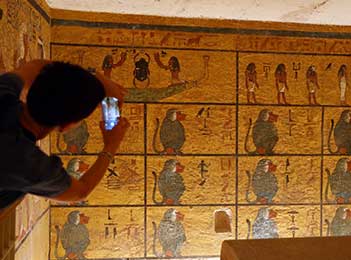One of the most remarkable ancient Egyptian temples included almost in all tours to Egypt, especially with Nile Cruises, The Temple of Kom Ombo is dedicated to the god Sobek, the crocodile god in ancient Egypt and the god Horus as well.
Numerous tourists coming from all over the world to enjoy their vacation in Egypt visit the Temple of Kom Ombo, one of the best-preserved temples of ancient Egypt, regularly.
Geographical Location of the Temple of Kom Ombo
The city and the temple of Kom Ombo are located around 40 kilometers to the North of Aswan on the East Bank of the River Nile. The temple of Sobek in Kom Ombo is located overseeing the River Nile in a distinctive place between fields of sugarcane.
Kom Ombo can be reached by bus or a rented taxi either from Aswan or Luxor. However, most of the tourists who travel to Egypt would explore the temple as part of their visits program in their Nile Cruise as the city of Kom Ombo is located between Luxor and Aswan and it is included in any Nile Cruise package between the two cities.
The History and the construction of the Temple of Kom Ombo
The name Kom Ombo means the hill of gold in the ancient Egyptian language. The original name of the temple is actually Nebo, which was modified to be Enbo in the Coptic language and then Ombo when pronounced in the Arabic language.
The ancient Egyptians believed that the city of Kom Ombo was the theatre of many struggles between the gods. Moreover, although the temple we view today was constructed in the Ptolemaic and Roman eras, Kom Ombo was inhabited as early as the prehistoric era in Egypt.
The Temple of Kom Ombo was built on the ruins of a much older ancient Egyptian temple that was constructed in the ruling period of Queen Hatshepsut or Tuthmosis III who belonged to the 18th dynasty of the New Kingdom of ancient Egypt.
The construction work of the Temple of Kom Ombo started in the reign of the King Ptolemy V at the end of the 2nd century BC. His successor, Ptolemy VI, who ruled Egypt in the period from 180 till 145 BC constructed many sections of the temple.
Many Ptolemaic kings participated in the building process of the Temple of Kom Ombo which was finished around the year 218 AD during the reign of the king Caracalla. It took the ancient Egyptians double the period of time that was spent in the construction of the Temple of Edfu to finish the Temple of Kom Ombo which took more than 400 years to be completed.
The Ptolemies have constructed the Temple of Kom Ombo for the worship of two ancient Egyptian gods, the local crocodile god; Sobek, and the famous falcon god, Horus. This is why the temple actually consisted of two temples one to the left and one to the right with each having all the features of a complete temple.
The Description of the Temple of Kom Ombo
The outline of the Temple of Kom Ombo has a rectangular shape with the typical planning of the temples constructed in the Roman and Ptolemaic periods in Egypt. The outline of the temple is quite similar to this of the Temple of Philae, Dendera, and Edfu.
The facade of the temple of Kom Ombo is featured for having a set of stairs at the Southern west section of the temple. These stairs lead to the gate of the temple that consists of a huge building constructed out of rocks. The facade of the temple is featured with scenes showing different Ptolemaic kings defeating their enemies, presenting offerings to the crocodile god, Sobek, and worshipping the falcon god, Horus.
Unfortunately, the pylon of the temple of Kom Ombo is actually now ruined. However, some of its Eastern sections show some scenes of a Ptolemaic king with religious inscriptions dedicated to the gods Sobek and Horus.
The pylon leads the guests to the open courtyard of the temple with its rectangular shape. It contains sixteen huge columns surrounding it and five columns at the Eastern and Western sections of the temple. However, only the bases of some of these columns survived until today.
In the middle of the courtyard there is an altar that was used to prepare the offerings and scarifies presented to the gods. All the columns of the open courtyard have some remarkable scenes of different Ptolemaic gods worshipping the gods.
Afterwards, the guests enter inside the inner open courtyard that is smaller than the outer one with ten columns situated in parallel lines. These columns are featured with wonderful stone capitals at the top with the papyrus flower ornamenting them. This section is also featured with scenes of presenting the gods Sobek, Horus, and Hathour with various offerings.
The first inner hall of the temple of Kom Ombo is the largest among the three inner halls inside the temple. It has the shape of a rectangle with scenes of the king Ptolemy VI worshiping the gods Horus and Sobek and in other scenes presenting wine to the goddess Hathour and her husband, god Sobek.
The second and the third inner halls of the Temple of Kom Ombo share the same features with the first one. They all have these notable portrays of Ptolemaic kings in religious scenes worshiping the gods Sobek and Horus.
Apart from any other ancient Egyptian temples constructed in any period of history, the Temple of Kom Ombo is featured for having two sanctuaries as they the temple was dedicated to two gods.
The two sanctuaries consist of two chambers and they were both constructed in the ruling period of Ptolemy VI. Although most of the sections of these two chambers are more or less completely ruined today, we know, through their outlines that they were built higher than the rest of the temple to hide the religious rituals that were carried out inside them during the Ptolemaic period.
The Temple of Kom Ombo also offers the guests enjoying their vacations in Egypt with a demonstration of how the ancient Egyptians mummified crocodiles and how they used to worship this local god in the Ptolemaic period.
The Temple of Kom Ombo, the same as many other Pharaonic constructions in Egypt embodies the greatness of the ancient Egyptians and how they were brilliant in their establishments that fought to survive until today to amaze tourists visiting Egypt from all over the world.

